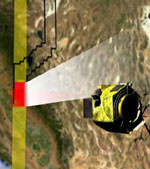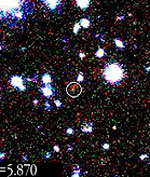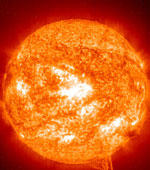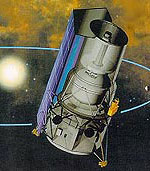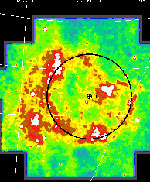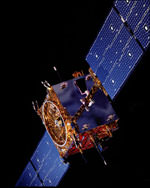
Image credit: NASA
Since it arrived at Mars in 1997, the Mars Global Surveyor has been searching the surface of the Red Planet for carbonate minerals. Large quantities of this substance would be evidence that the planet was once warm and wet, with large oceans and seas on the surface. Surveyor has found trace quantities of the mineral spread evenly in the dust of the planet, but no deposits, indicating that the planet was probably always icy and cold.
After a decades-long quest, scientists analyzing data from NASA’s Mars Global Surveyor spacecraft have at last found critical evidence the spacecraft’s infrared spectrometer instrument was built to search for: the presence of water-related carbonate minerals on the surface of Mars.
However, the discovery also potentially contradicts what scientists had hoped to prove: the past existence of large bodies of liquid water on Mars, such as oceans. How this discovery relates to the possibility of ephemeral lakes on Mars is not known at this time.
The thermal emission spectrometer on Global Surveyor found no detectable carbonate signature in surface materials at scales ranging from three to 10 kilometers (two to six miles) during its six-year Mars mapping mission. However, the sensitive instrument has detected the mineral’s ubiquitous presence in martian dust in quantities between two and five percent. Planetary geologists Timothy Glotch Dr. Joshua Bandfield, and Dr. Philip Christensen of Arizona State University, Tempe, analyze the data from dust-covered areas of Mars in a report to be published Aug. 22 in the journal Science.
“We have finally found carbonate, but we’ve only found trace amounts in dust, not in the form of outcroppings as originally suspected. This shows that the thermal emission spectrometer can see carbonates — if they are there ? and that carbonates can exist on the surface today,” said Christensen, principal investigator for the instrument.
“We believe that the trace amounts that we see probably did not come from marine deposits derived from ancient martian oceans, but from the atmosphere interacting directly with dust,” Christensen said. “Tiny amounts of water in Mars’ atmosphere can interact with the ubiquitous dust to form the small amounts of carbonate that we see. This seems to be the result of a thin atmosphere interacting with dust, not oceans interacting with the big, thick atmosphere that many people have thought once existed there.”
“What we don’t see is massive regional concentrations of carbonates, like limestone,” said Bandfield, who spent a year refining the techniques that allowed the group to separate carbonate’s distinctive infrared signature from the spectrometer’s extensive database of infrared spectra, despite the mineral’s low concentrations and the masking effects of the martian atmosphere.
“We’re not seeing the white cliffs of Dover or anything like that,” he said. “We’re not seeing high concentrations, we’re just seeing ubiquitously low levels. Wherever we see the dust, we see the signature that is due to the carbonate.”
Because there are known to be deposits of frozen water on Mars, the findings have important implications for Mars’ past climate history.
“This really points to a cold, frozen, icy Mars that has always been that way, as opposed to a warm, humid, ocean-bearing Mars sometime in the past,” said Christensen. “People have argued that early in Mars history, maybe the climate was warmer and oceans may have formed and produced extensive carbonate rock layers. If that was the case, the rocks formed in those purported oceans should be somewhere.”
Although ancient carbonate rock deposits might have been buried by later layers of dust, Christensen pointed out that the global survey found no strong carbonate signatures anywhere on the planet, despite clear evidence of geological processes that have exposed ancient rocks.
Bandfield said that carbonate deposits in dust could be partially responsible for Mars’ atmosphere growing even colder, to become as cold, thin and dry as it is today.
“If you store just a couple percent of carbonate in the upper crust, you can easily account for several times the Earth’s atmospheric pressure,” Bandfield said. “You can store a lot of carbon dioxide in a little bit of rock. If you form enough carbonates, pretty soon your atmosphere goes away. If that happens, you can no longer have liquid water on the surface because you get to the point where liquid water is not stable.”
“The significance of these dramatic results may have to wait for the discoveries to be made by the Mars Exploration Rovers in 2004 and the Mars Reconnaissance Orbiter in 2006 and beyond,” stated Dr. Jim Garvin, NASA’s lead scientist for Mars exploration. What’s important is that we have found carbon-bearing minerals at Mars, which may be linked to the history of liquid water and hence to our quest to understand whether Mars has ever been an abode for life.”
The Mars Global Surveyor mission is managed for NASA’s Office of Space Science, Washington, D.C. by the Jet Propulsion Laboratory, a division of the California Institute of Technology, Pasadena. Arizona State University built and operates the Thermal Emission Spectrometer on Mars Global Surveyor. Lockheed Martin Space Systems, Denver, developed and operates the spacecraft.
Original Source: NASA/JPL News Release

